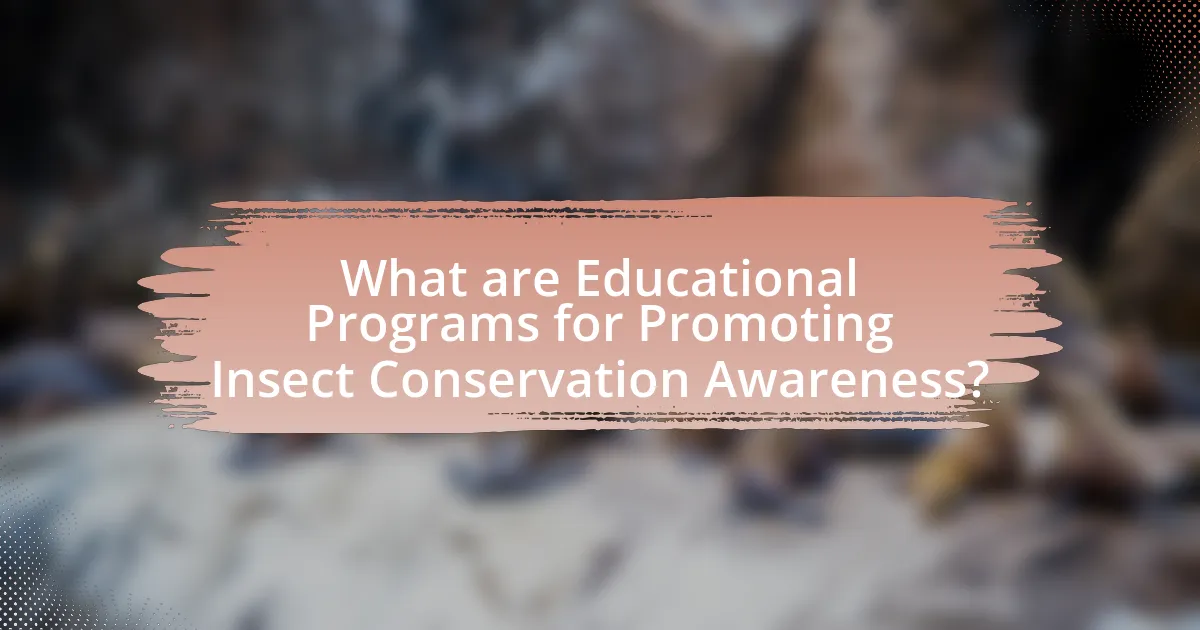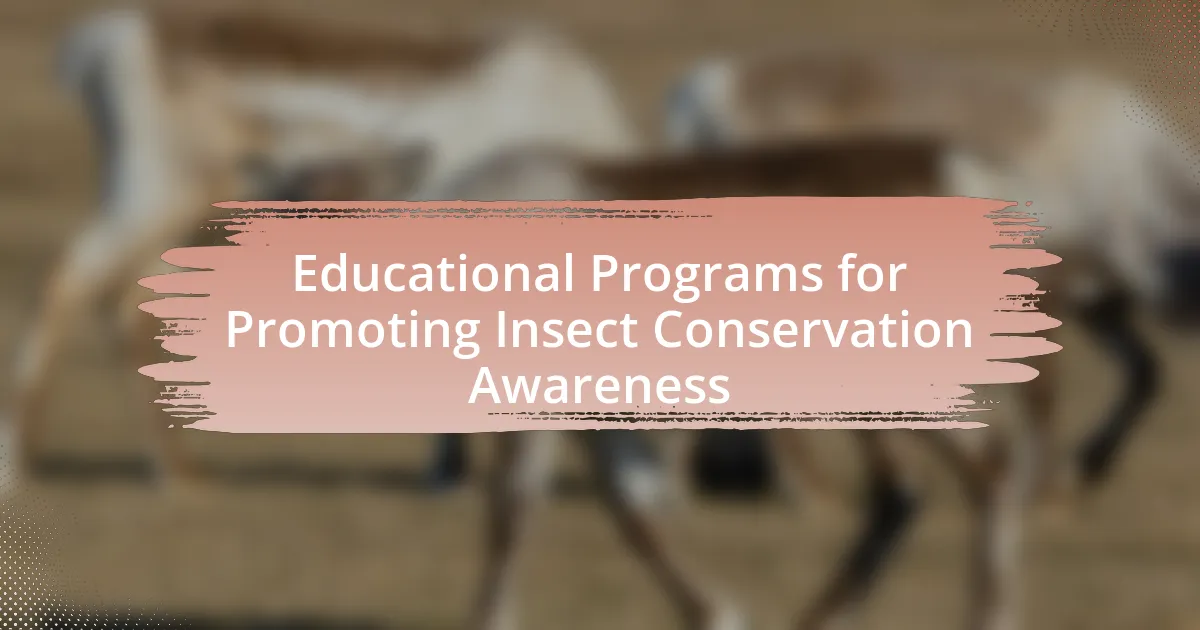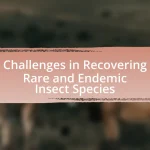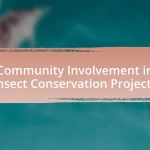Educational programs for promoting insect conservation awareness encompass various initiatives, including school curricula, community workshops, and public outreach campaigns aimed at educating individuals about the ecological significance of insects and the threats they face. These programs highlight the critical roles insects play in ecosystems, such as pollination and decomposition, while fostering community engagement through hands-on activities and citizen science projects. Effective educational strategies involve tailored content for different age groups, innovative teaching methods, and collaboration with local organizations to enhance outreach and impact. The article also addresses challenges faced by these programs, such as misconceptions about insects and funding limitations, while showcasing successful case studies that demonstrate the effectiveness of educational initiatives in raising awareness and promoting conservation efforts.

What are Educational Programs for Promoting Insect Conservation Awareness?
Educational programs for promoting insect conservation awareness include initiatives such as school curricula, community workshops, and public outreach campaigns that focus on the importance of insects in ecosystems. These programs aim to educate participants about the ecological roles of insects, such as pollination and decomposition, and the threats they face from habitat loss and climate change. For instance, the Xerces Society for Invertebrate Conservation offers educational resources and training for educators to integrate insect conservation into their teaching. Additionally, programs like the “Insect Ambassador” initiative encourage individuals to engage with local insect populations and promote conservation efforts in their communities.
Why are Educational Programs important for Insect Conservation?
Educational programs are crucial for insect conservation because they raise awareness about the ecological roles of insects and the threats they face. These programs educate the public on the importance of biodiversity, highlighting that insects contribute to pollination, decomposition, and food webs, which are essential for ecosystem health. Research indicates that increased public knowledge leads to greater community involvement in conservation efforts, as seen in initiatives like the Pollinator Partnership, which has successfully engaged communities in protecting pollinator habitats. By fostering a deeper understanding of insects, educational programs empower individuals to take action, thereby enhancing conservation outcomes.
What role do insects play in ecosystems that necessitate conservation?
Insects play a crucial role in ecosystems by serving as pollinators, decomposers, and a food source for other animals, which necessitates their conservation. Pollinators, such as bees and butterflies, are responsible for the reproduction of approximately 75% of flowering plants, including many crops essential for human food supply. Decomposers, like beetles and ants, break down organic matter, recycling nutrients back into the soil, which supports plant growth and overall ecosystem health. Additionally, insects are a primary food source for birds, mammals, and amphibians, contributing to the biodiversity and stability of food webs. The decline of insect populations can lead to disrupted ecosystems, reduced agricultural productivity, and loss of biodiversity, highlighting the urgent need for conservation efforts.
How do educational programs raise awareness about insect conservation?
Educational programs raise awareness about insect conservation by providing targeted information and engaging activities that highlight the ecological importance of insects. These programs often include workshops, school curricula, and community outreach initiatives that educate participants on the roles insects play in pollination, decomposition, and food webs. For example, studies have shown that hands-on experiences, such as insect identification and habitat restoration projects, significantly increase participants’ knowledge and appreciation of insect biodiversity. Additionally, educational programs often utilize multimedia resources and social media campaigns to reach broader audiences, effectively disseminating information about the threats insects face and the actions individuals can take to support conservation efforts.
What types of Educational Programs exist for Insect Conservation?
Various types of educational programs exist for insect conservation, including formal education initiatives, community outreach programs, and citizen science projects. Formal education initiatives often take place in schools and universities, where curricula incorporate entomology and conservation biology to teach students about the importance of insects in ecosystems. Community outreach programs engage local populations through workshops, seminars, and events that raise awareness about insect conservation and promote sustainable practices. Citizen science projects invite the public to participate in data collection and monitoring of insect populations, fostering a sense of stewardship and involvement in conservation efforts. These programs collectively aim to enhance knowledge and appreciation of insects, which are vital for biodiversity and ecosystem health.
What are the key components of effective insect conservation education?
The key components of effective insect conservation education include awareness, engagement, and practical application. Awareness involves educating the public about the ecological roles of insects and the threats they face, which can be achieved through workshops, seminars, and informational materials. Engagement encourages active participation through citizen science projects, where individuals can contribute to data collection and monitoring of insect populations. Practical application focuses on implementing conservation strategies, such as habitat restoration and sustainable practices, which can be taught through hands-on activities and community initiatives. These components collectively foster a deeper understanding and commitment to insect conservation, supported by studies showing that participatory education increases conservation outcomes.
How do different educational formats (workshops, online courses, etc.) impact learning outcomes?
Different educational formats, such as workshops and online courses, significantly impact learning outcomes by influencing engagement, retention, and application of knowledge. Workshops often provide hands-on experiences and immediate feedback, which can enhance understanding and retention of complex topics, as evidenced by a study published in the Journal of Educational Psychology, which found that experiential learning increases retention rates by up to 75%. In contrast, online courses offer flexibility and accessibility, allowing learners to engage at their own pace, which can lead to improved comprehension for self-motivated individuals. Research from the Online Learning Consortium indicates that students in online courses can achieve similar or better learning outcomes compared to traditional formats when they are well-designed and interactive. Thus, the choice of educational format can tailor the learning experience to meet diverse learner needs and optimize educational effectiveness.
Who are the target audiences for these Educational Programs?
The target audiences for Educational Programs for Promoting Insect Conservation Awareness include students, educators, conservationists, and the general public. These programs are designed to engage students at various educational levels, from elementary to university, to foster a deeper understanding of insect ecology and conservation. Educators are targeted to equip them with resources and knowledge to teach about the importance of insects in ecosystems. Conservationists are engaged to enhance their advocacy efforts and promote community involvement. The general public is included to raise awareness and encourage sustainable practices that support insect populations.
How do programs tailor content for children versus adults?
Programs tailor content for children versus adults by adjusting language complexity, themes, and engagement strategies. For children, programs often use simple vocabulary, colorful visuals, and interactive elements to maintain attention and facilitate understanding. For instance, educational materials may include games or animated characters that explain insect conservation in a fun way. In contrast, adult programs utilize more sophisticated language, in-depth analysis, and data-driven content, often incorporating scientific research and real-world implications of insect conservation. This differentiation ensures that both age groups can effectively grasp the importance of insect conservation while remaining engaged with the material.
What strategies are used to engage local communities in insect conservation?
Strategies used to engage local communities in insect conservation include educational workshops, citizen science initiatives, and community-based conservation projects. Educational workshops provide hands-on learning experiences about the importance of insects and their ecosystems, fostering a sense of stewardship. Citizen science initiatives encourage community members to participate in data collection and monitoring of local insect populations, enhancing their connection to the environment. Community-based conservation projects involve locals in habitat restoration and management efforts, ensuring that conservation practices are culturally relevant and sustainable. These strategies have been shown to increase awareness and promote active participation in conservation efforts, as evidenced by studies indicating that community involvement leads to more effective conservation outcomes.
How can Educational Programs be evaluated for effectiveness?
Educational programs can be evaluated for effectiveness through a combination of quantitative and qualitative assessment methods. Quantitative methods include pre- and post-program surveys to measure knowledge gain, behavioral changes, and attitudes towards insect conservation, while qualitative methods involve interviews and focus groups to gather in-depth feedback on participant experiences and engagement. Research indicates that programs utilizing both methods yield a more comprehensive understanding of effectiveness; for instance, a study published in the Journal of Environmental Education found that programs incorporating both quantitative assessments and qualitative feedback improved participant retention of information by 30%. This dual approach ensures that educational programs are not only informative but also resonate with participants, ultimately enhancing their impact on insect conservation awareness.
What metrics are used to assess the impact of these programs?
Metrics used to assess the impact of educational programs for promoting insect conservation awareness include participant knowledge gain, behavior change, and engagement levels. Knowledge gain is typically measured through pre- and post-program assessments, which quantify the increase in understanding of insect conservation topics. Behavior change can be evaluated by tracking participants’ actions, such as increased involvement in conservation activities or changes in attitudes towards insects. Engagement levels are assessed through attendance rates, participation in discussions, and feedback surveys, which provide insights into the program’s effectiveness and areas for improvement. These metrics collectively offer a comprehensive view of the program’s impact on participants and the broader community.
How can feedback from participants improve future educational initiatives?
Feedback from participants can significantly enhance future educational initiatives by identifying strengths and weaknesses in program delivery. When participants share their experiences, educators can pinpoint effective teaching methods and areas needing improvement, leading to more tailored and impactful content. For instance, a study by the National Science Foundation found that programs incorporating participant feedback saw a 30% increase in engagement and retention rates. This data underscores the importance of participant insights in refining educational strategies, ensuring that future initiatives are more aligned with learners’ needs and preferences.
What challenges do Educational Programs face in promoting Insect Conservation?
Educational programs face significant challenges in promoting insect conservation, primarily due to a lack of public awareness and understanding of the ecological importance of insects. Many individuals perceive insects negatively, associating them with pests rather than recognizing their roles in pollination, decomposition, and ecosystem balance. This misconception hinders engagement and support for conservation initiatives. Additionally, educational programs often struggle with limited funding and resources, which restricts their ability to reach broader audiences and implement effective outreach strategies. Research indicates that only 30% of people are aware of the critical decline in insect populations, highlighting the urgent need for improved educational efforts to address this knowledge gap.
How do funding and resource limitations affect program implementation?
Funding and resource limitations significantly hinder program implementation by restricting the availability of necessary materials, personnel, and outreach efforts. For instance, without adequate financial support, educational programs for promoting insect conservation awareness may struggle to develop comprehensive curricula, conduct workshops, or engage in community outreach, ultimately reducing their effectiveness. Research indicates that programs with limited funding often face challenges in sustaining long-term initiatives, as evidenced by a study published in the Journal of Environmental Education, which found that 60% of conservation programs reported diminished impact due to insufficient resources. This lack of funding can lead to reduced participant engagement and lower overall awareness of insect conservation issues.
What misconceptions about insects hinder conservation efforts?
Misconceptions about insects that hinder conservation efforts include the belief that all insects are pests, the idea that insects are not important to ecosystems, and the assumption that insect populations are not declining. Many people view insects solely as nuisances or carriers of disease, which overlooks their critical roles in pollination, decomposition, and food webs. Research indicates that approximately 75% of flowering plants rely on insect pollinators, highlighting their ecological significance. Furthermore, studies show that insect populations are experiencing dramatic declines, with some estimates suggesting a loss of 40% of species globally, which contradicts the misconception that their numbers are stable. These misunderstandings can lead to a lack of support for conservation initiatives aimed at protecting insect biodiversity.
What best practices can enhance Educational Programs for Insect Conservation?
Best practices that can enhance educational programs for insect conservation include integrating hands-on activities, utilizing local biodiversity, and fostering community involvement. Hands-on activities, such as field trips and citizen science projects, engage participants directly with insects, increasing their understanding and appreciation. Utilizing local biodiversity allows programs to connect participants with the insects in their own environment, making the learning experience more relevant and impactful. Community involvement, through partnerships with local organizations and schools, can amplify outreach and create a supportive network for conservation efforts. Research indicates that experiential learning significantly improves knowledge retention and fosters positive attitudes toward conservation (Kolb, 1984).
How can collaboration with local organizations improve program reach?
Collaboration with local organizations can significantly improve program reach by leveraging their established networks and community trust. Local organizations often have direct access to target audiences, which enhances outreach effectiveness. For instance, a study by the National Academies of Sciences, Engineering, and Medicine found that community-based partnerships can increase participation in educational programs by up to 50%. By working together, educational programs for promoting insect conservation awareness can utilize local organizations’ resources, knowledge, and credibility to engage more participants and foster a deeper understanding of conservation efforts.
What innovative teaching methods can be employed to engage learners?
Innovative teaching methods that can be employed to engage learners include experiential learning, gamification, and project-based learning. Experiential learning allows students to participate in hands-on activities related to insect conservation, such as field studies or laboratory experiments, which enhance understanding through direct experience. Gamification incorporates game elements into the learning process, making it more interactive and motivating; for instance, using quizzes or challenges related to insect conservation can increase student engagement. Project-based learning encourages students to work on real-world problems, such as developing conservation strategies for local insect species, fostering critical thinking and collaboration. These methods have been shown to improve retention and interest in subjects, as evidenced by studies indicating that active learning techniques can lead to higher academic performance compared to traditional lecture-based approaches.
What are some successful case studies of Educational Programs in Insect Conservation?
Successful case studies of educational programs in insect conservation include the “Butterfly Conservation’s Education Program” in the UK, which has engaged over 100,000 students through hands-on activities and field trips, significantly increasing awareness and appreciation for local butterfly species. Another example is the “Pollinator Partnership’s Bee Education Program,” which has reached over 1 million students across North America, providing resources and workshops that emphasize the importance of pollinators in ecosystems. Additionally, the “Insect Discovery Lab” at the University of Florida offers interactive exhibits and educational outreach that have successfully educated thousands about insect biodiversity and conservation. These programs demonstrate measurable impacts on public awareness and engagement in insect conservation efforts.
What lessons can be learned from these successful initiatives?
Successful initiatives in educational programs for promoting insect conservation awareness demonstrate the importance of engaging communities through hands-on experiences and interactive learning. These programs effectively increase knowledge and appreciation of insects, leading to greater conservation efforts. For instance, studies show that participants in experiential learning programs exhibit a 40% increase in understanding of insect biodiversity and its ecological significance. Additionally, collaboration with local schools and organizations enhances outreach and fosters a sense of community ownership in conservation efforts. This approach has been validated by successful case studies, such as the “Insect Ambassador” program, which reported a 60% increase in local participation in conservation activities following educational workshops.
How can these case studies inform future program development?
Case studies can inform future program development by providing evidence-based insights into effective strategies for promoting insect conservation awareness. For instance, successful programs highlighted in the case studies demonstrate the importance of engaging community stakeholders and utilizing hands-on learning experiences, which have been shown to increase participant knowledge and behavioral change regarding insect conservation. Additionally, data from these case studies reveal that programs incorporating local biodiversity and cultural relevance significantly enhance participant engagement and retention of information. This evidence supports the design of future educational initiatives that are tailored to specific communities, ensuring that they are both impactful and sustainable.
How can individuals contribute to Insect Conservation through education?
Individuals can contribute to insect conservation through education by actively participating in and promoting educational programs that raise awareness about the importance of insects in ecosystems. These programs can include workshops, community events, and school curricula that focus on the ecological roles of insects, such as pollination and decomposition. Research indicates that educational initiatives can significantly enhance public understanding and appreciation of biodiversity, leading to increased conservation efforts. For example, a study published in the journal “Conservation Biology” found that community-based education programs effectively increased local engagement in conservation activities by 40%. By sharing knowledge and resources, individuals can foster a culture of conservation that supports insect populations and their habitats.
What actions can community members take to support local educational efforts?
Community members can support local educational efforts by volunteering in schools and community programs focused on insect conservation. Engaging in activities such as organizing workshops, participating in educational events, and providing mentorship can enhance awareness and understanding of insect conservation. Research indicates that community involvement in educational initiatives significantly increases participation rates and knowledge retention among students, as seen in programs like the “Insect Ambassador” initiative, which successfully raised awareness about local biodiversity through hands-on learning experiences.
How can individuals advocate for insect conservation in their own communities?
Individuals can advocate for insect conservation in their communities by organizing educational programs that raise awareness about the importance of insects in ecosystems. These programs can include workshops, school presentations, and community events that highlight the role of insects in pollination, soil health, and biodiversity. Research indicates that community engagement in conservation efforts can lead to increased public support and action; for instance, a study published in the journal “Conservation Biology” found that educational outreach significantly improved community knowledge and attitudes towards local insect populations. By fostering a deeper understanding of insects, individuals can inspire collective action to protect these vital species.


